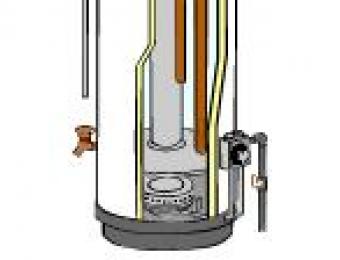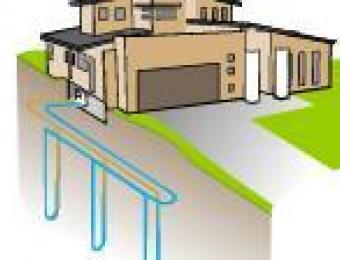How geothermal water heaters work
Geothermal hot water systems can operate on one of two principles: either by drawing heat from a natural hot spring, or by drawing it directly from the ground.
The more exotic hot spring method draws hot water or steam from a naturally occurring hot spring, using it to heat a water tank (the water is often not suitable for drinking directly). These installations are obviously only possible if there is a hot spring nearby, so they are rarely a practical choice.
The more common method can be installed almost anywhere, and operates by extracting warmth directly from the earth. It is based on the same principle as heat pump technology, but takes its heat from the ground instead of the air. At a depth of 3 metres, the ground temperature levels out to approximately 12-13° C.
Copper tubing is piped into the ground in a long loop and refrigerant is circulated through the pipe. The refrigerant absorbs heat from the earth and is transferred back up the pipe, where it is compressed to allow the transfer of heat to the water in a storage tank.
Types of geothermal hot water system
Geothermal systems are currently only designed to operate with a storage tank. The key variation in geothermal systems is how the pipes are arranged. A vertical layout is more costly to lay down, but a horizontal layout takes up more underground real estate. Owners of smaller properties may have no choice but to take on the vertical piping option.
Under the ground, pipes are often looped or coiled to allow for a greater amount of pipe to be heated.
Where are geothermal hot water systems most commonly found?
Geothermal systems are not common in Australia as there has been little exposure to this system on the market. Geothermal systems increase their effectiveness with size, and as a result are more popular for commercial rather than domestic use.
Is a geothermal system for me?
A geothermal system can make an interesting and environmentally friendly alternative to the standard offerings. It operates similarly to a heat pump system but without variations in temperature affecting the end result. Obviously geothermal systems need access to the ground, so they are usually an unsuitable choice for above ground floor apartments and high rise buildings.
Likewise, the savings and low environmental impact of using a geothermal hot water heater must be offset against the considerable installation costs and logistics.
Installation requirements
You will need an area of ground that is free from existing underground piping (check with your water, gas, electricity and telecommunications suppliers) and sufficient space for excavation equipment to dig out the trench for the piping.
Other considerations are similar to those for a heat pump system.
|
Advantages
|
Disadvantages
|



